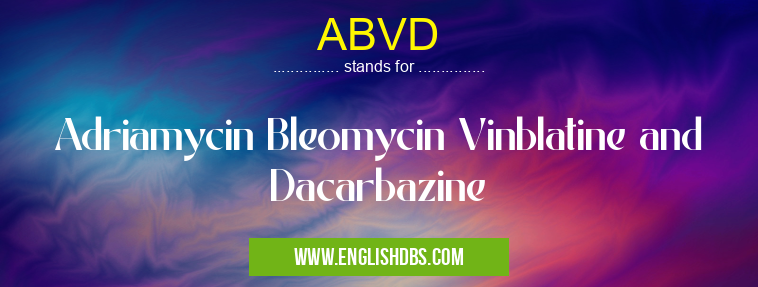What does ABVD mean in UNCLASSIFIED
ABVD is an abbreviation that stands for the four main drugs used in a chemotherapy regimen for the treatment of certain types of cancer, particularly Hodgkin lymphoma. This combination of drugs has proven to be highly effective in achieving remission and long-term survival in many patients.

ABVD meaning in Unclassified in Miscellaneous
ABVD mostly used in an acronym Unclassified in Category Miscellaneous that means Adriamycin Bleomycin Vinblatine and Dacarbazine
Shorthand: ABVD,
Full Form: Adriamycin Bleomycin Vinblatine and Dacarbazine
For more information of "Adriamycin Bleomycin Vinblatine and Dacarbazine", see the section below.
Full Form and Mechanism of Action
The full form of ABVD is:
- Adriamycin (doxorubicin): An anthracycline antibiotic that damages DNA and kills cancer cells.
- Bleomycin: An antibiotic that inhibits DNA synthesis and damages cell membranes.
- Vinblastine: A vinca alkaloid that disrupts cell division by inhibiting mitosis.
- Dacarbazine (DTIC): An alkylating agent that damages DNA and inhibits cell replication.
Treatment Protocol
ABVD chemotherapy is typically administered in cycles, with each cycle lasting 28 days. The drugs are given intravenously (IV) on specific days of the cycle. The dose and duration of treatment may vary depending on the patient's individual case and response to therapy.
Efficacy and Safety
ABVD is considered a highly effective chemotherapy regimen for Hodgkin lymphoma. Studies have shown that it can achieve remission rates of up to 90% and long-term survival rates of over 80%. However, it is important to note that ABVD can have certain side effects, including nausea, vomiting, hair loss, low blood counts, and potential long-term effects on the heart and lungs.
Essential Questions and Answers on Adriamycin Bleomycin Vinblatine and Dacarbazine in "MISCELLANEOUS»UNFILED"
What is ABVD?
ABVD is a chemotherapy regimen used to treat Hodgkin's lymphoma. It consists of four drugs: Adriamycin, Bleomycin, Vinblastine, and Dacarbazine.
How is ABVD administered?
ABVD is typically given as an intravenous infusion every 2-3 weeks for 6-8 cycles.
What are the side effects of ABVD?
Common side effects of ABVD include nausea, vomiting, hair loss, fatigue, and reduced white blood cell count. Less common but more serious side effects include lung damage, kidney damage, and heart problems.
How effective is ABVD?
ABVD is highly effective in treating Hodgkin's lymphoma. In clinical trials, it has been shown to achieve a complete remission rate of over 80%.
What are the long-term effects of ABVD?
Some patients who receive ABVD may experience long-term side effects, such as infertility, thyroid problems, and an increased risk of secondary cancers.
Is ABVD the only treatment for Hodgkin's lymphoma?
No, there are other treatment options for Hodgkin's lymphoma, including radiation therapy, other chemotherapy regimens, and stem cell transplant. The best treatment approach will vary depending on the stage of the disease and the patient's overall health.
Final Words: ABVD is a widely used and effective chemotherapy regimen for the treatment of Hodgkin lymphoma. It has a proven track record of achieving high remission rates and long-term survival in many patients. However, it is essential for patients to be aware of the potential side effects and to work closely with their healthcare team to monitor their response to treatment and manage any adverse effects that may arise.
ABVD also stands for: |
| All stands for ABVD |
